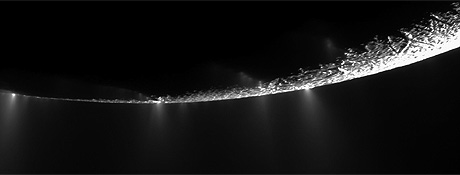Saltwater Reservoirs under the Icy Crust of Saturn’s Moon Enceladus
22 June 2011

© NASA/JPL/Space Science Institute
Embargo time: 22 June 2011, 7.00 pm Central European Time (CET)
Research by Heidelberg scientists indicates that there must be liquid saltwater reservoirs just under the icy crust of Saturn’s moon Enceladus. They have analysed the composition of particles taken from the water plumes jetting into space from the surface of Enceladus. The samples were collected in the course of direct fly-throughs by the Cassini-Huygens spacecraft, a NASA/ESA/ASI mission. The findings from these fly-throughs enlarge on earlier work done by the team of scientists from the Max Planck Institute of Nuclear Physics and Heidelberg University. They will be published in „Nature“.
Enceladus’ water plumes shoot water vapour and tiny grains of ice into space. They originate from the so-called “tiger stripe” surface fractures at the moon’s south pole and create the faint E-ring that traces the orbit of Enceladus around Saturn. The Cassini spacecraft discovered the plumes in 2005 and more recently has been able to fly directly through them. During three of Cassini’s passes in 2008 and 2009, the Cosmic Dust Analyzer (CDA) measured the composition of freshly ejected plume grains. The icy particles hit the detector target at speeds of between 6.5 and 17.5 km/s, and vapourised instantly. Electrical fields inside CDA then separated the various constituents of the resulting plasma cloud for analysis.
Dr. Frank Postberg, who works both at Heidelberg University’s Institute of Earth Sciences and the Max Planck Institute of Nuclear Physics, is the scientist in charge of these investigations. He points out that far away from Enceladus, the ejected grains are relatively small and mostly salt-poor, closely matching the composition of the E-ring. Closer to the moon, however, Cassini has found relatively large, salt-rich ice grains. More than 99% of the total mass of solids ejected appears to take the form of salt-rich grains. “But most of them are too heavy,” says Dr. Postberg, “and they fall back onto the surface of the moon, never making it to the E-ring.”
The salt-rich particles have an “ocean-like” composition, which indicates that most, if not all, of the ice expelled comes from sub-surface liquid saltwater, rather than from the icy surface of the moon. “When salt water freezes slowly, the salt is squeezed out, leaving pure water ice behind,” says Dr. Postberg. “So if the plumes were coming from solid ice, there should be very little salt in them. Accordingly, there is currently no other plausible explanation for the steady outflow of salt-rich grains from the tiger stripes than salt water under Enceladus’ icy surface.”
The picture the team envisages is that deep underneath Enceladus’ surface, perhaps 80 km down, there is a layer of water between the rocky core and the icy mantle, kept liquid both by tidal forces emanating from Saturn and some neighbour moons and by the heat generated from radioactive decay. Salt in the rock dissolves into the water, which accumulates in liquid reservoirs beneath the icy crust. When the outermost layer cracks open, the reservoir is exposed to space. The drop in pressure causes the liquid to evaporate, with some of it flash-freezing into salty ice grains. Together these create the plumes. As other research has shown, roughly 200 kg of water vapour is hurled out into space every second through “vents” in the tiger stripes together with smaller amounts of ice grains. According to the team’s calculations, the water reservoirs must have large evaporating surfaces. “If they didn’t,” Dr. Postberg emphasises, “they would easily freeze over, and that would be the end of the plumes.”
Also involved in this research were scientists from Potsdam University, Braunschweig Technical University, Stuttgart University, the University of Colorado (Boulder, USA) and The Open University in Milton Keynes (UK). The Cassini-Huygens mission is a joint endeavour of ESA, NASA and the Italian space Agency, ASI. Launched in 1997, the Cassini spacecraft arrived in the Saturn system in 2004 and is studying the ringed planet and its moons.
Note for news desks:
Digital picture material is available from the Press Office.
Original publication
F. Postberg, J. Schmidt, J. Hillier, S. Kempf & R. Srama: A saltwater reservoir as the source of a compositionally stratified plume on Enceladus, Nature online, 22 June 2011, doi:10.1038/nature10175
Contact:
Frank Postberg
Max Planck Institute of Nuclear Physics,
Institute of Earth Sciences, Heidelberg University
phone: +49 6221 516543, frank.postberg@mpi-hd.mpg.de
Communications and Marketing
Press Office
phone: +49 6221 542311
presse@rektorat.uni-heidelberg.de

